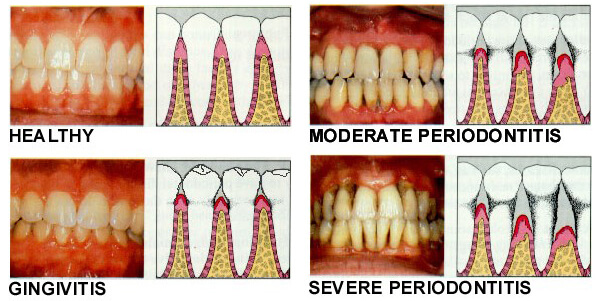
Receding gums are a condition in which your gums pull back from the tooth surface, exposing the root surfaces of your teeth. It’s just one form of gum (periodontal) disease. This is a serious consequence of poor oral health, which may lead to tooth loss. There are a variety of treatments available, depending on the severity of tissue loss. The earlier the diagnosis and treatment, the better the outcome.
Causes and Risk Factors for Receding Gums
It is estimated that three out of every four adults have some form of periodontal disease. This includes receding gums.
Periodontal disease is a progressed form of gingivitis. It first starts off with a buildup of bacteria and plaque within the gums and the teeth. Over time, stuck-on plaque damages the gums and causes them to fall back from the teeth. In severe cases, pockets form between the teeth and gums. This creates a breeding ground for even more bacteria and plaque to form.
Receding gums may be caused by a number of factors, including:
- aggressive brushing over the long term
- hardened plaque buildup (tartar)
- smoking
- hormonal changes in women
- family history of gum disease
- diabetes
- HIV

Symptoms of Receding Gums
- Symptoms of receding gums include:
- bleeding after brushing or flossing
- red, swollen gums
- bad breath
- pain at the gum line
- visibly shrinking gums
- exposed tooth roots
- loose teeth
Receding gums and other forms of periodontal disease are diagnosed by a dentist. A physical examination can indicate issues. A probe may also be used to measure gum pockets. A probe is a process that uses a small, painless ruler. According to the
A diagnosis of receding gums may warrant a referral to a periodontist.
Treatment
Medications
A periodontist can determine the best course of treatment to save gum tissues and your teeth. First, if an infection is found in the gums, antibiotics may be prescribed.
Other medications may also be used to treat the underlying problem that is causing gum recession. Options include:
- topical antibiotic gel
- antiseptic chips
- antimicrobial mouthwash
- enzyme suppressants
Surgery
Surgery may be used in the worst cases of receding gums. There are generally two options: flap surgery and grafting.
Flap surgery is a deep tissue cleaning used if other treatments fail. It gets rid of bacteria and tartar buildup within the gums. In order to perform this surgery, a periodontist lifts up the gums and then puts them back in place when the procedure is over. Sometimes the teeth appear even longer after flap surgery because the gums fit more closely around them.
In grafting, the goal is to revive either gum tissues or the bones. During the procedure, the periodontist places either a synthetic particle or a piece of bone or tissue to help the gums grow back. It’s important to note that this process cannot be successful over the long term without proper oral health care.
Complications of Receding Gums
The CDA estimates that periodontal diseases such as receding gums are responsible for about 70 percent of adult tooth loss. When there is not enough gum tissue to hold tooth roots in place, the teeth are vulnerable to falling out. In some instances, multiple loose teeth are removed by the dentist before they fall out.
Advanced cases of receding gums will likely require surgery to prevent further damage.
Preventing Receding Gums
Perhaps one of the best tools for preventing receding gums is to see a dentist for regular cleanings and checkups. Even if you don’t experience any symptoms, a dentist can identify early signs of gum disease. You can also help prevent gum problems by practicing smart oral health habits.
While regular flossing and brushing removes bacteria, food particles, and plaque, tartar may only be removed with a dental cleaning. Since tartar can contribute to gum disease and receding gums, this is why biannual cleanings are so vital in preventing these types of complications.
Talk To Us
The outlook for early stages of gum disease can be good — but only if the problem is treated early. You also don’t have to wait for a dentist to detect signs of receding gums. If something in your mouth doesn’t look or feel right, give your dentist a call right away. You may be able to treat gingivitis before it progresses into receding gums.
Plaque buildup that sits for too long can cause tartar to form on your teeth. This can destroy your tooth enamel and increase your risk of gum disease.
By following a daily routine of brushing, flossing, and twice-yearly visits to the dentist, you can limit plaque buildup and reduce the risk of tartar forming on your teeth and gums.
If you have any questions about receding gums, schedule an appointment with a dental health professional.
To book an appointment or find out more, call Morgan Street Dental Centre today on 02 69219500!
